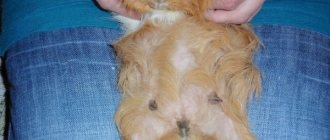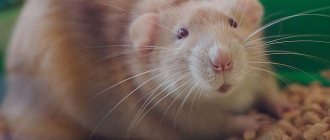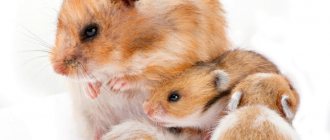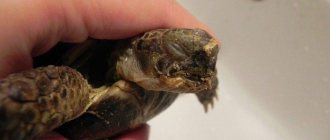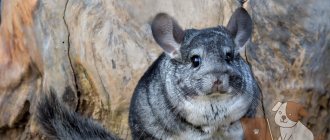Stress
A sensitive animal may be frightened by:
- Incorrect handling (lifting by the tail, rough catching);
- Loud screams, unexpected roar, knocking and unusual sound.
- The annoying company of children and the curiosity of cats or dogs.
- Change of cage.
- Finding neighbors.
- Injuries during a fight from blows against the bars of the cage.
Under natural conditions, shedding fur helps the rodent escape the teeth and claws of its enemies. In a home environment, if handled carelessly, tufts of wool remain in the hands of the owner. Another evidence of stress is excessive shedding or gnawing of fur from the sides.
Having noticed signs of fear, it is necessary to find out its causes, change the way of communication and create acceptable conditions for the existence of the animal. The fur will grow back in 2-3 weeks.
To adapt a newly acquired pet you should:
- Do not pick him up for 2-3 days, wait until the chinchilla calms down and begins to get acquainted with the home.
- Start communication in the morning, without sudden movements, placing your hand under your tummy.
- Give the second one a sniff so that the animal remembers the smell of its owner.
- For the first week, do not try to pet the chinchilla.
ATTENTION! Trust and affection are achieved through patience and affection.
There are several signs of vitamin deficiency
Misfeeding
A lack of vitamins in an animal’s body, or vitamin deficiency, occurs very often due to the fact that the feeding diet is incorrectly formulated and consists of monotonous food. Most often, chinchillas encounter vitamin deficiency in the spring or autumn, because there is a reduction in succulent green food, due to the fact that it is very difficult to get it.
Improperly formulated diet Overcoming vitamin deficiency is quite simple:
- introduction of vitamins or injections into the diet, which include veterinary drugs containing essential microelements;
- Along with food, they give fresh fruits, vegetables, and herbs.
Vitamins are given for 14 days, dosage occurs individually for each animal.
We suggest you read: Feeding rabbits at home
Vitamins in excess lead to hypervitaminosis, one of the signs of this disease is also loss of fur, and in addition to this symptom, problems develop:
- with cardiovascular activity;
- breathing;
- digestion.
Lack of vitamins and minerals
The disheveled appearance of the rodent, faded, brittle fur sticking out in all directions, bare sides are signs of vitamin deficiency. Sometimes the skin may become red and itchy. This occurs in spring or early winter. The lack of juicy vegetables and fruits, berries, herbs in the diet, lack of salts and vitamins, and monotonous nutrition are its cause.
To prevent this phenomenon, you should feed the animal with ready-made, high-quality food from trusted manufacturers. The veterinarian will tell you in what proportions to introduce hay, apples, oats, alfalfa, nettle, rose hips, and hawthorn into the diet. He will also prescribe treatment for symptoms of vitamin deficiency. These are most often vitamins for wool in injections or drops.
Fungus
Fungal infections cause diseases such as trichophytosis and microscopy, otherwise these ailments are called lichen. The diseases have similar symptoms: it all starts with the appearance of regularly defined oval or round scaly or blistered areas on the chinchilla’s skin. Then hair loss begins, and if you miss the moment and do not carry out treatment, then in a very short time the animal will become completely bald.
If the veterinarian confirms the presence of lichen, the owner should remember that the disease is very contagious and can be transmitted to humans. Animals are treated with injections, tablets, sprays, ointments - it all depends on the degree of damage.
Microclimate disturbance
The natural conditions for exotic animals are a mountain climate, where the temperature is constant at 16-18 degrees. That is why they have such beautiful, thick fur. Exceeding the temperature provokes hair loss to cool the body.
Extreme heat, stale air, and high humidity can lead to redness, peeling of the skin and even death. To avoid this, in winter you do not need to place the chinchilla’s cage near heating devices and radiators, or place it on windowsills in direct sunlight. In summer, to create a comfortable temperature you need air conditioning and the absence of drafts.
Shedding
It is not for nothing that chinchillas have such thick and dense hair. The fact is that these cute rodents are high-altitude animals that spend their entire lives in cold climates. And they need fluffy fur to stay warm. A full-fledged shedding with the appearance of bare spots would be a real test for chinchillas. Therefore, high-mountain animals are not subject to this physiological process.
However, chinchillas, like any other animal, are not 100% protected from hair loss. 20-30 hairs fall out of their luxurious coats every day. This is not visible to the naked eye, since the hairs are mixed with the litter, which is regularly removed.
In addition, chinchillas do have a small planned shedding once in their life - during the change from a child's coat to an adult one, at the age of about a year. During this period, the pet loses 150-200 hairs per day, and this is considered the absolute norm. After 3-4 months, the young animal’s coat will completely change and molting will stop.
Dermatitis
Skin diseases cause unbearable suffering to cute animals. To get rid of the itching, they rush around restlessly, scratch with blood and quickly lose a lot of hair.
The cause of dermatitis is impaired metabolism, intolerance to dietary components, and pathogenic fungus. If a disease is detected, you cannot treat it yourself. It will be prescribed by a veterinarian after a complete examination.
Often hair falls out due to allergies
Allergic dermatitis
The desire to pamper your pet (more often occurring in children) with oranges, melons, exotic vegetables and fruits, and smoked products causes this disease. Less commonly, it occurs when changing food, eating untreated sand, and introducing toxic toys. Symptoms of allergic dermatitis:
- The animal often sneezes, itches and chews itself.
- Eyes turn red.
- Breathing disturbance appears, accompanied by wheezing or whistling.
- Bare islands of skin are formed.
You can eliminate the causes of allergic reactions by selecting food, explaining feeding rules to children, washing the cage and throwing away toys, especially those that have a strong unpleasant odor.
Allergy
If the body is hypersensitive to various irritants, the following symptoms can be observed in an animal:
- conjunctivitis;
- inflammation of the eyelids;
- lacrimation;
- sneezing;
- dyspnea.
An allergic reaction accompanies the following situations:
- switching from one type of feed to another, this applies to both ready-made mixtures and those prepared by the owner (dusty hay);
- bedding materials;
- hygienic sand for bathing chinchillas;
- an allergic reaction to toxic substances released by internal parasites.
Conjunctivitis in chinchillas
Lichen
Microscopic fungi brought from outside by animals or people are the cause of lichen. Round or oval bald patches of skin appear that quickly increase in size. They are located on the nose, around the eyes, on the paws and near the tail.
If action is not taken quickly, the rodent's entire body will become a complete bald spot, covered with a flaky crust. This is dangerous not only for sick animals, but also for all inhabitants of the house. If the animal begins to itch and bite its fur, there is a reason for a careful examination. If lichen is detected, be sure to visit a veterinarian with all animals, including cats and dogs.
ATTENTION! If an infection is detected, the first thing to do is isolate the rodent and disinfect the cage. Add mycodermatitis to the bathing sand.
If a visit to the veterinarian is not possible, the lesions should be treated with one of the drugs: lamisil, exoderil, chlorhexidine, medical sulfur. If extensive damage is observed, 1/14 tablets of Nizoral are administered daily for a month. If you have the Vakderm F vaccine, give injections of 0.3-0.5 ml for 10 days. After missing 10 days, the course is repeated. You need to do 30 injections. Possible increased hair loss.
IT IS IMPORTANT! Before purchasing chinchillas, be sure to study the list of necessary medications and first aid kit equipment.
Prevention
Any problem is much easier to prevent than to solve. Therefore, in order not to encounter the appearance of bald spots in a chinchilla’s fur coat, it is better to take care of simple preventive measures in advance:
- Protect the chinchilla from possible stress - place the cage in a remote room where strangers cannot easily enter, do not play loud music, and prevent other pets from attacking the chinchilla.
- Take care of the animal’s comfort - prevent the fluffy from overheating, maintain air humidity at 45-50%, and regularly clean the cage.
- Provide your pet with a balanced diet containing vitamins and other vital micro- and macroelements. In this case, it is necessary to exclude potential allergens from the chinchilla’s diet - citrus fruits, peanuts, stone berries, honey.
- Give the animal more time . For a fluffy to feel comfortable, it is enough for him to spend only 1-1.5 hours a day with his owner.
- Monitor your chinchilla's health . It is advisable to take your pet for preventive examinations to a veterinary hospital 1-2 times a year. This will help to identify in time or completely prevent the development of pathologies in the animal.
Why does a chinchilla lose hair is a rather complex question to which there is no clear answer. In any case, you should never leave your pet’s baldness unattended. Otherwise, the animal may become completely bald. If you have any doubts about the causes of hair loss and treatment options, it is best to consult a veterinarian. Under the supervision of a specialist, the chinchilla’s fur coat will be restored as quickly as possible.
Diseases
Any disease affects the appearance of the animal - the fur gets wet, the hairs become brittle and fall out profusely. If such symptoms appear simultaneously with discharge from the eyes, ears, mouth, nose, etc., this is a reason for a careful examination and identification of the disease. Most often the gastrointestinal tract suffers from:
- Diarrhea. The reason is overexcitement, bad water or moldy food. Treat with herbal infusions (calamus, wild rosemary) and phthasol with charcoal. If treatment is unsuccessful, biomycin or tetracycline is given (the dosage is determined by the veterinarian).
- Constipation. The reason is infection, lack of water, stress. If the abdomen is hard and there are no signs of bowel movements, a laxative, plenty of fluids and juicy fruits should be given.
- Gastroenteritis. The intestines and stomach are inflamed due to poor nutrition or a sudden change in nutrition. Treat with rosehip decoction and a balanced meal.
The animal will have bad fur and will stop moving due to diseases of the genital organs, mammary glands, malocclusion, bad teeth, jaundice, and cystitis. Only a professional can handle such serious diseases.
A chinchilla can gnaw its own fur.
Why does a chinchilla chew its fur?
When the fur disappears from the sides of the animals, the bald spots are cracked and bleeding, which means that it has been chewed out. This could be done by a cage neighbor or the chinchilla herself brought herself into this state.
There are several reasons for this behavior, after which the behavior of the animals returns to normal. They are:
- Metabolism is disrupted due to a lack of vitamin D, saturated fatty acids, and methionine. Calcium and phosphorus are unbalanced in the diet. To solve the problem, the rodent is offered finely chopped lard and methionine is added to the food.
- Ticks, fleas, lice. To get rid of them, the cage is disinfected, the animals are bathed, and a special collar is put on (a collar for kittens is suitable to avoid poisoning, since collars for adults have a strong dose of poison).
- Aggression of relatives. The animal should be calmed down and placed in another cage.
- Emotional imbalance. Such animals do not participate in reproduction; they need to be occupied with treats or interesting objects.
- Hormonal stress during pregnancy and breastfeeding. During this period, it is necessary to introduce vitamin supplements, calcium gluconate, sprouted wheat, juicy vegetables and fruits into the diet. The hormonal levels will restore themselves when the female returns to her normal state.
- Boredom. If an active animal does not communicate with anyone, it lives in a long-inspected, unequipped cage, without toys. We need to give him the opportunity to occupy himself, sit him down with a friend, pet him and pick him up.
What to do if your British cat sheds a lot
In order to shorten the shedding period of a British cat, veterinary experts recommend using the following methods:
- Switch your pet to high-quality food and ensure your pet receives the necessary vitamins and microelements.
- In the autumn, reduce daylight hours for your pet - there is no need to leave your British cat in a lighted room in the evenings.
- Do not let the animal sleep on radiators or in other warm places. Be sure to ventilate the room at night.
- The air in the room where the cat is kept should not be dry.
In any case, such measures will help the molt proceed without complications and provide the animal with the greatest comfort.
Grooming
Regular brushing of fur during shedding is necessary not only to reduce soiling of carpets and sofas. This process is extremely important for the health of the British:
- during combing, the skin in the growth zone of the root bulbs is massaged;
- metabolism improves;
- the undercoat layer is ventilated.
If a cat is accustomed to brushing and does not panic at the sight of a brush, it enjoys it and its health improves.
Antiparasitic treatments
A mandatory procedure for British breed cats is annual vaccination and treatment against parasites (external and internal). These measures do not directly affect the molting process, but they improve health, prevent the development of a number of diseases and are always considered in conjunction with other preventive measures.
If a small British kitten sheds heavily, then first of all you need to ask whether its mother has been treated for worms, fleas and lice. Most often, at an early age, they become the cause of active shedding of fur.
Changing the indoor microclimate
The living conditions of a British cat affect how the pet sheds. In this sense, everything must be done to ensure that the animal experiences at least minimal changes in temperature and humidity, since the body is guided by the length of daylight hours and the accompanying climatic conditions.
The cat owner must:
- regularly ventilate the room;
- provide walks on the street or at least equip a place for the cat on the balcony;
- maintain an appropriate level of humidity in the house/apartment - dry air completely changes the structure of the hair and the molting cycle.
It is necessary to provide the animal with the opportunity to climb to high places and settle down there. Even within the same room, but at different levels, temperature and humidity change, and the cat itself finds the most comfortable place.
Reducing stress levels
The most common cause of stress for a British cat is noisy company in the house and lack of privacy. The breed prefers solitude rather than constant communication. Failure to comply with this condition leads to increased emotional stress, which can result in aggression or lead to the onset of prolonged molting. Once the source of the irritation is eliminated, your Briton will be at peace and will return to his normal coat changing routine.
